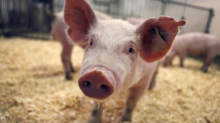
© The Globe and MailEnviropig
The small herd of pigs in a research barn in Guelph look like ordinary pigs.
They act like ordinary pigs, and presumably, they would even taste like ordinary pigs if anyone dared to break the law and sample one.
But these are Enviropigs. The transgenic creations of university researchers, they are the world's most controversial environmentally sensitive swine, and they're not legally fit to eat. At least, not yet.
Under development for more than a decade, the University of Guelph's 20 Enviropigs are close behind a Canadian-made supersized salmon in a race to become the first genetically modified animals allowed into the food system.
Starting with the discovery that an E.coli gene could produce a digestive enzyme that regular pigs lack, the Guelph scientists realized they could introduce genetic material from that bacterium into pigs to minimize the environmental impact of the animals' waste, reducing a major pollutant from large-scale production - and allowing pork producers to cut operation costs.
The market may soon need Enviropig. To feed the projected world population of nine billion in 2050, food production will have to increase by 70 per cent, according to the Food and Agriculture Organization of the United Nations. Genetically engineered organisms will have to be part of the equation, according to the globe-spanning community of experts concerned with meeting those looming targets.
"You cannot feed the world at affordable prices without using the modern arsenal of inputs," said Marco Ferroni, head of the Syngenta Foundation, a Swiss-based non-profit established by its namesake seed company to pursue sustainable improvements in farm yields.
